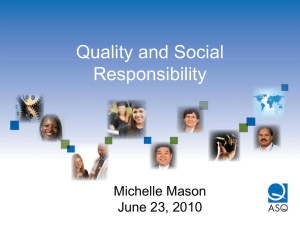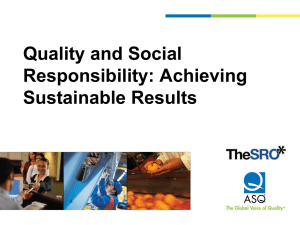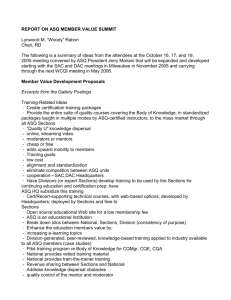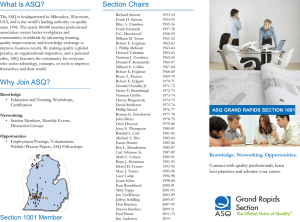Planning for Quality in Education K-12
advertisement
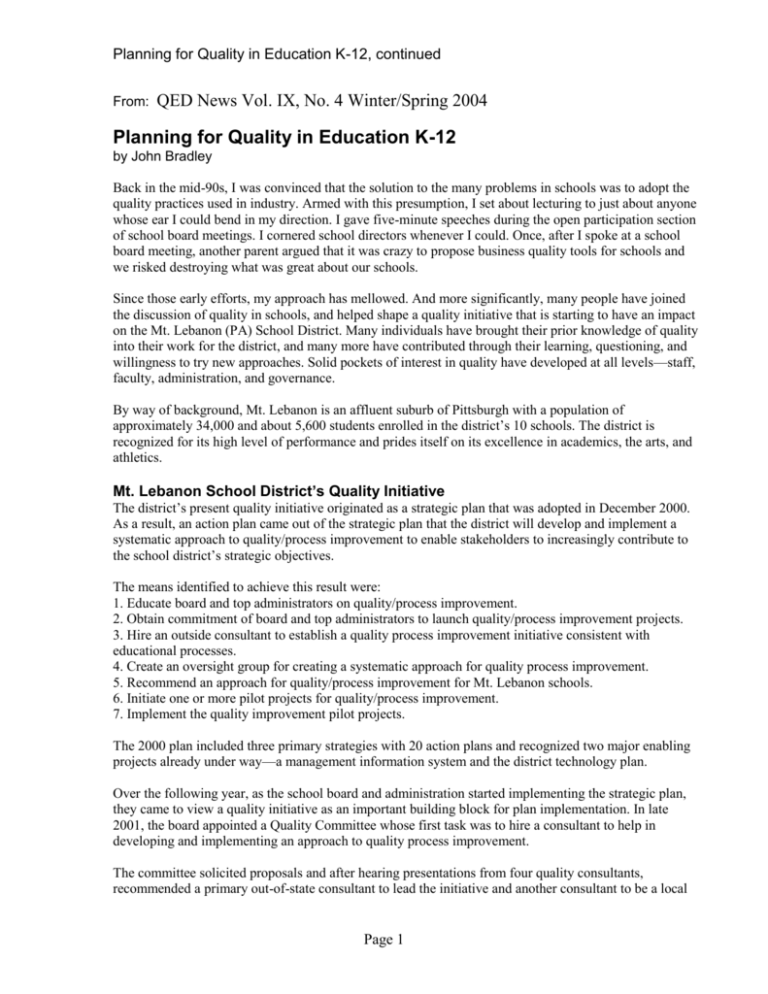
Planning for Quality in Education K-12, continued From: QED News Vol. IX, No. 4 Winter/Spring 2004 Planning for Quality in Education K-12 by John Bradley Back in the mid-90s, I was convinced that the solution to the many problems in schools was to adopt the quality practices used in industry. Armed with this presumption, I set about lecturing to just about anyone whose ear I could bend in my direction. I gave five-minute speeches during the open participation section of school board meetings. I cornered school directors whenever I could. Once, after I spoke at a school board meeting, another parent argued that it was crazy to propose business quality tools for schools and we risked destroying what was great about our schools. Since those early efforts, my approach has mellowed. And more significantly, many people have joined the discussion of quality in schools, and helped shape a quality initiative that is starting to have an impact on the Mt. Lebanon (PA) School District. Many individuals have brought their prior knowledge of quality into their work for the district, and many more have contributed through their learning, questioning, and willingness to try new approaches. Solid pockets of interest in quality have developed at all levels—staff, faculty, administration, and governance. By way of background, Mt. Lebanon is an affluent suburb of Pittsburgh with a population of approximately 34,000 and about 5,600 students enrolled in the district’s 10 schools. The district is recognized for its high level of performance and prides itself on its excellence in academics, the arts, and athletics. Mt. Lebanon School District’s Quality Initiative The district’s present quality initiative originated as a strategic plan that was adopted in December 2000. As a result, an action plan came out of the strategic plan that the district will develop and implement a systematic approach to quality/process improvement to enable stakeholders to increasingly contribute to the school district’s strategic objectives. The means identified to achieve this result were: 1. Educate board and top administrators on quality/process improvement. 2. Obtain commitment of board and top administrators to launch quality/process improvement projects. 3. Hire an outside consultant to establish a quality process improvement initiative consistent with educational processes. 4. Create an oversight group for creating a systematic approach for quality process improvement. 5. Recommend an approach for quality/process improvement for Mt. Lebanon schools. 6. Initiate one or more pilot projects for quality/process improvement. 7. Implement the quality improvement pilot projects. The 2000 plan included three primary strategies with 20 action plans and recognized two major enabling projects already under way—a management information system and the district technology plan. Over the following year, as the school board and administration started implementing the strategic plan, they came to view a quality initiative as an important building block for plan implementation. In late 2001, the board appointed a Quality Committee whose first task was to hire a consultant to help in developing and implementing an approach to quality process improvement. The committee solicited proposals and after hearing presentations from four quality consultants, recommended a primary out-of-state consultant to lead the initiative and another consultant to be a local Page 1 Planning for Quality in Education K-12, continued resource for continued training as the initiative unfolds. Hank Grimmick, a senior Baldrige examiner from California, was the lead consultant, and the local consultant was Craig Vogel, a dean and professor of industrial design at Carnegie Mellon University (CMU). Vogel had been involved with CMU’s quality program for several years and is a Mt. Lebanon resident. Both of these consultants have played valuable roles in our journey—Grimmick’s vast experience with many types of organizations in adopting quality and Vogel’s combination of quality work in an academic institution and his expertise in the process design. The consultants proceeded to lead the committee through a process to adopt a Baldrige approach to conduct an internal assessment, and select two pilot projects. The intent in selecting two pilot projects was to demonstrate quality practices in time for the coming school year. The committee developed a list of 11 practical problems for which a solution would affect work life and provide a statement about quality. The two projects adopted addressed areas of considerable discontent—the purchasing process and the work order process. Teams were formed, trained, and supported to do their projects. Even though the projects were not completed in time for a start-of-school kickoff, the final outcomes were highly successful. The just-in-time training program eliminated waste and significantly improved teacher satisfaction with the supply process. In October, an Internal Assessment Team, consisting of 10 members of faculty, administration, and PTA, was trained and supported to conduct a Baldrige self-assessment. The team collectively spent more than 1800 hours conducting interviews, gathering and analyzing data, and preparing a report to the district. The report, first presented in December 2002, was very well received and represented a milestone in open selfexamination for the district and public acknowledgment that an excellent school district can strive for significant improvement. By early 2003, the successes of the internal assessment and pilot projects provided a strong foundation for the initiative. Project presentations were repeated throughout the district to reinforce the recommendations and educate on quality. An additional challenge for the district in 2003 was to prepare for the retirement of the superintendent, Dr. Glenn Smartschan, and search for a new superintendent. The internal assessment team recommended six high-leverage action items. After review by the administration, the Quality Committee, and the board, a decision was made to fund two additional projects for the year 2003-04: Develop and implement a systematic process to evaluate, measure, and drive continuous improvement in faculty/staff well-being, satisfaction, and motivation. Develop a systematic process to compare the district with other educational organizations as well as organizations outside of education. In spring 2003, the school district underwent a significant administrative change with import for the quality initiative—the retirement of Superintendent Glenn Smartschan and the hiring of a new superintendent, Dr. Marge Sable. With a set of board-directed goals to be accomplished, Dr. Sable embraced the quality initiative and determined that the Quality Committee was the appropriate vehicle through which major planning should occur. Over the summer, the Quality Committee was restructured and expanded with five subcommittees charged to: Develop a systematic process to evaluate, measure, and drive continuous improvement in faculty/staff well-being, satisfaction, and motivation. Develop a systematic process to compare the district with other educational organizations as well as organizations outside of education (i.e., benchmarking). Develop preventive maintenance systems for facilities, including grounds (e.g., a follow through on the work order pilot project). Page 2 Planning for Quality in Education K-12, continued Develop a relevant plan to move the district toward becoming a world-class learning community within five years (i.e., strategic planning) Develop an effective system for the district to identify private grant funds and implement such systems. As of this writing in January 2004, the work in each of these areas is under way with expanded teams, trainers/facilitators, and a commitment to and grounding in quality practice. Reflections on Changes The events of the past four years have laid a solid foundation for the quality initiative. Most significantly, we have proved that a systematic approach to quality process improvement can add real value to the work of our school district. Second, through the work of the committee, the internal assessment, and the pilot projects, a significant core of 30-50 district employees and volunteers have gained a solid foundation in quality practices and theory and a corresponding commitment. A significant portion of these core people have attended Baldrige and other quality in education conferences and there is a growing discussion of applying quality tools in the classroom. And finally the quality initiative and perspective is being blended into the administrative and governance structure of the district. In an outstanding school district like Mt. Lebanon, many administrative and policy practices are consistent with good quality. Often the growing knowledge of quality can reinforce existing good practices. An example of such a practice that is important for quality is a graduate survey that has been conducted for the past five years. This survey has been useful to the Quality Committee and to other committees such as the Technology Curriculum Committee convened in 2001. A graduate survey was sent out in the third or fourth year after graduation for the classes of 2000, 1999, 1998, 1997, 1996, and 1995. This feedback has been a useful illustration of the value of customer feedback as well as an eye opener about our strengths and areas for improvement. My Involvement Since the early ’90s, my involvement has gone through four phases: Parent/advocate for immediate issues affecting my children Advocacy for quality/process improvement Member of the Strategic Planning Committee (1999-2000) Member of MLSD’s Quality Committee My involvement began when my second child entered elementary school and was encountering the same problems as my first child. From discussion with parents, I knew these were issues not unique to my family. I also knew from my work in quality, that in many industries it would not be acceptable to not try to improve processes about which customers frequently complained. Advocacy Phase After several years of talking to the elementary school principal, I concluded I need to address district administrative processes. For lack of a better approach, I initiated a discussion with the superintendent about the school district’s approach to using customer feedback and the possibility of integrating this issue into the district’s planning process. I had had considerable professional experience using customer feedback and market research for quality/process improvement purposes in healthcare. I ended up on a planning subcommittee, late in a planning process, that emphasized inclusiveness and openness. This Page 3 Planning for Quality in Education K-12, continued discussion on customer feedback has been a significant theme, out of the limelight, for our district’s planning and quality concerns. To this day, I recognize that every complaint or problem I have had about my kids’ schools has been for lack of or due to a breakdown in an effective process at the classroom or unit level. This brief experience with a planning committee in 1995 led me to the belief that an educational campaign on quality approaches in industry was necessary, so I set out to find opportunities to talk to school board directors and administrators about quality. I utilized the open discussion period at the end of board meetings to deliver five-minute presentations on quality. I had breakfast with as many school directors as would meet with me. In these meetings I would try to focus on applications of quality relevant to their backgrounds. I researched quality practices in business and industry and discussed how such practices might be relevant to the school district. I nominated myself for vacancies on the board and used the interviews to expound on the school board’s need for more board members with quality and organizational development experience in industry. Whenever I came across relevant quality articles in my work, I would distribute them to those I thought might listen. One article that I believe was meaningful was from Quirk’s market research on a Delaware career technical school district that used graduate surveys to aid in planning curriculum improvements. Strategic Planning Phase In 1999 I was asked by a board member to apply to be on the Strategic Planning Committee. In that phone conversation, he expressed his appreciation for my efforts to help the board have a better understanding of quality. After several years of feeling isolated in my efforts and wondering how many people thought I was crazy, this was encouraging. I had also learned a lot about how to talk about quality in the schools environment. The Strategic Planning Committee involved a 30-person cross-section of the district and community. The process was led by consultants, Drs. Larry Huggins and Steve Barone of Transformation Systems, Ltd., who providing training and an efficient structured process. By acceptance of the ground rules that included decisions by consensus, I was agreeing to subordinate my particular interest. However, as the planning process progressed, I realized that I could make a contribution by demonstrating rather than advocating, quality practices and reframing issues in quality terms. The Strategic Planning Committee included several school directors and other members who had had direct experience with quality and organizational development (OD) initiatives in industry. In addition the action teams formed to elaborate on the key strategies also included several quality and OD professionals, including the ASQ section chair at that time. Throughout the planning process there seemed to be broad interest in quality processes and this general interest was important in how we framed issues in quality terms and in supporting the final recommendation. Quality Committee Phase Participation on the Quality Committee since 2002 has been gratifying in seeing so much go seemingly well. With capable people and professional training and guidance for the assessment and projects, there is less need for advocacy, and the opportunities for contribution are different. I find that I do a lot of listening, waiting, or looking for an opportunity to support or contribute. In the summer I was appointed to the Planning Subcommittee. With the expansion of the subcommittee structure, I have been trying to find ways to involve other ASQ professionals in the quality subcommittees to provide additional technical support. Although the involvement of additional ASQ experts in the process has been problematic, we have been able to put several senior ASQ members in contact with district staff. Presently, John Bauer, an ASQ Fellow has been involved in the Benchmarking Page 4 Planning for Quality in Education K-12, continued Subcommittee and has been a useful resource on non-education-related benchmarking. In general, however, school districts have a hard time effectively utilizing outside expert volunteers. Personal Challenges Over the years in ASQ, I have talked with many parents and professionals who would like to be involved in similar ways in their school districts. Below I recount some of the challenges I encountered during my nine years of personal involvement as a quality advocate in the school district. I cannot take credit for anything that has happened, but I like to think that I have helped to make some of it happen. Here are a few points to consider: What is your role? As a businessperson, or other professional, how can you make a significant contribution? One option is to run for the elective office of school director. I decided not to run for elective office on the premise that being a school director would so dilute my focus that I would not be able to effect meaningful change. This was as much my assessment of my personal capabilities as of the politics and pressures on school directors. Another option may be to serve as a consultant. I decided to not participate in a consulting proposal by local ASQ colleagues because I believed my freedom and effectiveness would be compromised in any role other than that of a volunteer. For most ASQ members, the only viable role will be as a volunteer to support, educate, and guide. And from this role, here are a few lessons learned: Listen actively If you are not an educator involved in your schools on a daily or weekly basis, it is hard to know what is going on or what people are thinking. And it is very easy to make wrong assumptions. It is necessary to spend a lot of time listening and resisting the urge to jump to conclusions. Effective advocacy is being an educator Advocacy means educating people on the issues and minimizing opposition. Finding ways to educate with appropriate aggressiveness and grace is always a challenge. . Look for allies for quality Quality terms as well as business terms can be threatening, distracting, or confusing in the public sector. It is clear that school directors, planning committee members, and PTA leaders who had had quality practice experience in their other lives often played important roles in sustaining interest in quality. Educators’ extensive background in areas of research techniques, program management, and human development contribute to their receptivity for quality concepts. These are the kinds of people to search out, get to know, and support in promoting an interest in quality. Learn the language Educators have their own language, as do other professions, where quality is critical—such as software engineering, medicine, and manufacturing. Like these other areas of applied advanced knowledge there are many levels of degrees, certifications, and accreditation. While the body of knowledge of quality and Page 5 Planning for Quality in Education K-12, continued of education may have considerable overlap, the language is not common, and communication about quality between the two professions can be difficult. It requires a lot of give and take to be talking the same language. Lay the groundwork and tackle easy issues first There are issues that I believe are critical for any school system to do an outstanding job in serving their customers, but the district is not ready to address those issues. An example is career and technical education, and the relationship between career and technical schools, and the suburban academic high schools. The current structure in Pennsylvania fails both the students in the career technical schools and the suburban academic schools. While many issues might be addressed at the subregional level, most suburban school districts are unwilling to change the boundaries of their planning in this area. From the work of Kenneth Gray (Getting Real: Helping Teens Find Their Future) it seems likely that many suburban students would benefit from other approaches to career counseling as well as technical curricula. Interestingly, in Pennsylvania, the most advanced formal work on quality is in ISO certification by the career and technical schools. As of mid-2003, I was aware of at least five schools that had achieved ISO registration. While I continue to moderately push issues such as this, the groundwork we are building with the quality initiative will allow us eventually to tackle the bigger issues. Maintain your focus and put aside your other issues While you might want to tackle a range of broader social issues relating to education, it is wise to stay out of issues with broader political implications. Having some background in public policy, I have a tendency to want to address broader policy issues that arise in school discussions. And when I ponder the relevance of quality improvement efforts in a suburban school district to the deeper social issues of work force development and widening inequity, learning how to manage educational systems effectively and guide change has importance for many areas of educational and economic policy. Look for areas where your school district is open for volunteers The openness of the Mt. Lebanon School District’s planning processes provided opportunities for local ASQ members to be involved in planning. My impression from attending the National Quality Education Conference in Columbus, OH, in 2002 is that there are many instances of ASQ members finding these openings for involvement. Clearly, States with formal quality programs for schools provide far more opportunities. Lessons Learned My conclusions from this experience are that organizational changes in a school district follow the same arduous paths as in any organization. A quality professional has the same challenges as any other outside change agent—communication, education, relationships, and support for the people who do the work of the organization. Throughout my involvement over the last 8-10 years, my participation in ASQ has been a valuable resource and source of moral support. Many members, in and out of the leadership, have enthusiastically explored all the issues with me and have discussed and offered valuable support. To me this is a fine example of the value of a professional organization and of the subtle ways we in ASQ pursue our community commitment. References 1. MLSD Strategic Plan, approved by the Board of School Directors, December 18, 2000— http://www.mtlsd.org/district/aboutus.asp 2. Baldrige Internal Assessment Report—Released January 2003— http://www.mtlsd.org/district/aboutus.asp Page 6 Planning for Quality in Education K-12, continued 3. “High Marks,” by William Stearrett Jr. of the New Castle (DE) Vocational Technical School District Quirk’s Market Research, Oct. 1994; available online at: http://www.quirks.com/articles/article.asp?arg_ArticleId=102 4. Kenneth Gray, Getting Real: Helping Teens Find Their Future, Corwin Press, 2000, Thousand Oaks, CA. 5. Jonathan Cagan and Craig Vogel, Creating Breakthrough Products: Innovation From Product Planning to Program Approval, Prentice Hall, 2002. John Bradley is the business/financial manager for a physician practice in Pittsburgh, PA. He holds a bachelor’s degree in history from Princeton University and master’s degrees in urban and regional planning, and in economics from the University of Pittsburgh. He can be reached at brad208@adelphia.net Page 7
